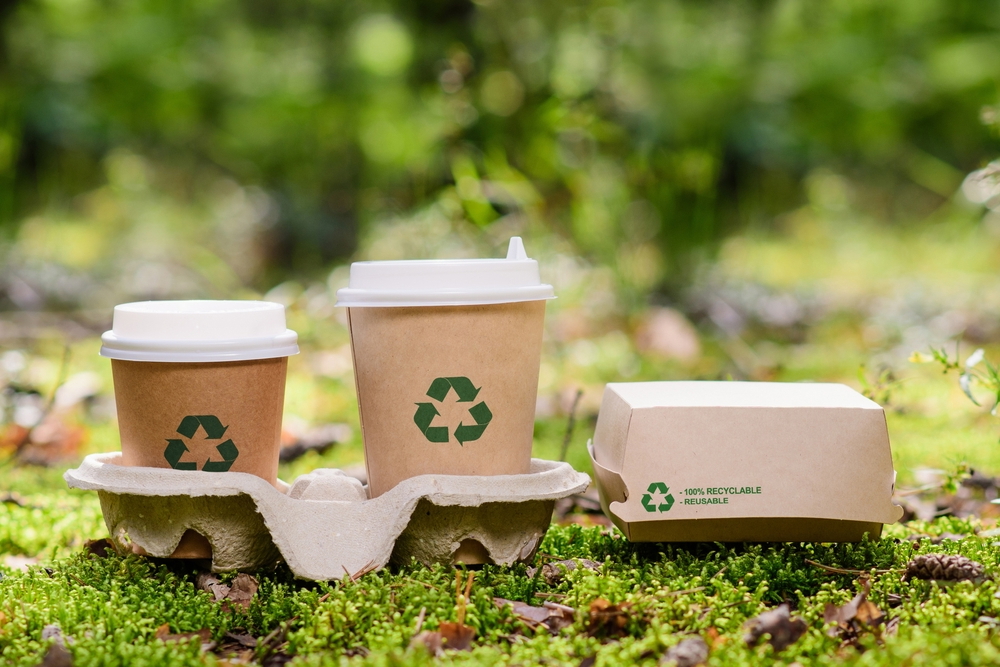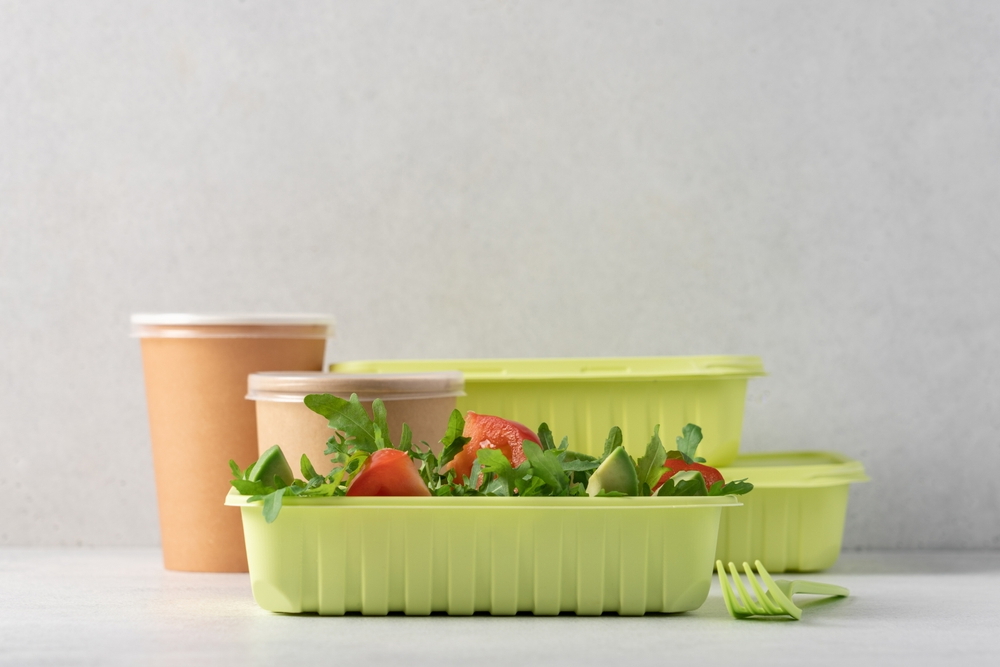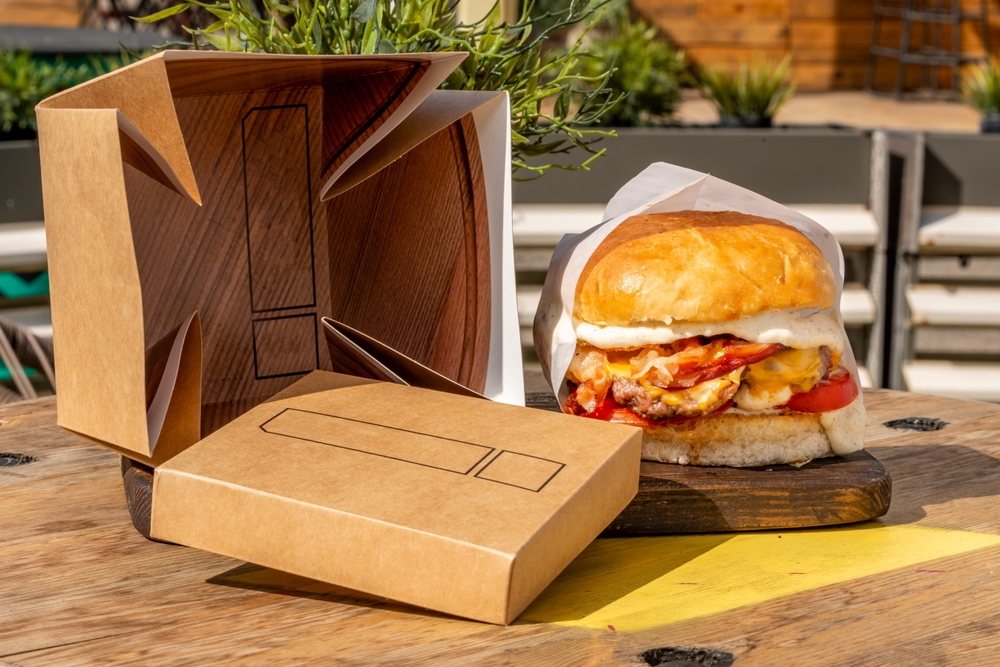How Companies Are Rethinking Takeaway Packaging for a Sustainable Future
By Morten Numrich · 13. August 2024
As environmental concerns take centre stage, restaurants, and food delivery services worldwide are facing a packaging paradigm shift.”
🌍From plant-based materials to returnable containers, we delve into the remarkable ways businesses are countering plastic waste and embracing sustainability.
Expect to uncover the breakthroughs and challenges in the industry’s journey toward a greener footprint, with practical examples illustrating this packaging revolution.
Innovating with Sustainable Materials
 ecofriendly food packaging
ecofriendly food packaging
In the crusade against plastic pollution, companies are turning over a new leaf, quite literally. The shift from synthetic to organic is reshaping the takeaway packaging landscape.
Businesses are reducing plastic waste and fostering a circular economy by adopting alternatives like bioplastics and paper bubble wrap.
The focus extends beyond merely substituting materials; it involves a comprehensive reconsideration of the packaging life cycle, including rethinking packaging reuse.
From foam chips made of natural sources to fully compostable wool insulation, every element is chosen to leave a lighter footprint on our planet.
Even adhesives are getting a green makeover with recyclable paper tape taking the stickiness out of our environmental woes.
It’s a comprehensive approach that ensures your takeaway packaging can go from your doorstep to the compost heap without a hitch.
From Plastic to Plants
Gone are the days when plastic was the go-to for food takeaway packaging. Whether it’s biodegradable packaging made of:
- bagasse, showing off its greaseproof prowess in lieu of petroleum-based containers
- areca palm leaves being fashioned into elegant, biodegradable bowls
- milk plastic and seaweed wrappers, offering moldable, edible options
Materials are getting a plant-based promotion, offering environmentally-friendly and innovative alternative materials.
The shift to sustainable packaging is not confined to the west coast; it’s spreading across the globe.
Elopak’s Pure-Pak eSense, for instance, is turning heads in the aseptic sector with its sustainably sourced paperboard, proving that even liquid containers can do without the plastic crutch.
This transformation goes beyond waste reduction; it involves revitalising materials that would have otherwise ended up in landfills by reconsidering the reuse of packaging.
Circular by Design
The circular economy isn’t a buzzword; it’s the backbone of a sustainable future. It’s about designing products that can make the round trip from production to disposal and back again, with minimal environmental impact.
Materials like Silberboard paper are stepping up, offering recyclable and biodegradable options that close the loop on waste.
Brands are realising that sustainable practices aren’t just good for the planet; they align with consumer expectations and corporate responsibility goals.
Take Splosh’s take-back system, which transforms used refill pouches into upcycled treasures, or IoT solutions that track packaging throughout its life, ensuring that nothing’s lost and everything’s gained in the pursuit of a circular economy.
Undoubtedly, rethinking packaging extends beyond merely substituting materials—it’s about envisioning new systems in a world where waste is passé.
The Rise of Reusable Container Models
 recyclable food containers
recyclable food containers
As we sail towards a sustainable future, the tide is turning against single-use plastics. Enter the era of the reusable container, where ‘single use’ is a dirty word and ‘repeated use’ is the chant of champions.
From refill stations to return systems, the food and beverage sector is getting a reusable makeover, with benefits like cost reductions and customer loyalty sweetening the deal.
Imagine sipping your favourite drink from a container that’s been around the block more times than the neighbourhood cat.
That’s the promise of services like ‘return on the go,’ which lets customers return packaging for a future discount, or ‘refill on the go,’ where your own reusable containers become vessels of sustainability.
This packaging reuse movement goes beyond re-imagining the reuse of packaging—it’s about reshaping our entire understanding of packaging.
Subscription Service for Sustainability
Who knew that sustainability could arrive on your doorstep every month? Subscription services are weaving reusable packaging into the fabric of our lives, with companies like Splosh and Loop leading the charge.
These aren’t just deliveries; they’re drops of environmental hope, cutting down on plastic waste one refill at a time.
Splosh sweetens the pot with a 10% discount on refills, proving that eco-friendly habits can be as kind to your wallet as they are to the planet.
Loop, on the other hand, has partnered with big brands to create durable, reusable packaging that customers can return for a refill, a la milkman style.
This is a contemporary take on a tried-and-true idea, demonstrating that subscribing to sustainable practices is the most effective way to ensure a greener future.
Collection Service Convenience
The convenience of collection services is like music to the ears of busy eco-warriors. Who has time to worry about where to toss their takeaway containers when companies like Splosh make it as easy as clicking ‘order’ online?
With systems in place to take back used packaging, the circle of sustainability spins effortlessly, leaving customers with nothing but satisfaction and a clear conscience.
Gone are the days of wondering what to do with empty bottles. Splosh’s simple online system means refills are just a click away, and their take-back program ensures those pouches live on, either reused or recycled.
It’s a shining example of how a collection service can turn the mundane task of recycling into a seamless part of the consumer experience.
Encouraging Consumer Participation
Ever wonder if your individual actions make a difference? Well, wonder no more! The success of sustainable packaging hinges on consumer participation.
Millennials, with their eco-conscious minds, are leading the charge, demanding brands to step up their game and offer packaging that doesn’t weigh heavily on the environment.
The movement is gaining momentum, with consumers, especially millennials, happily bringing their own reusable containers to the party.
This shift is not only crucial for the environment but also for businesses to keep up with the changing tides of consumer expectations.
As customers become more involved, they’re not just using sustainable packaging; they’re becoming ambassadors for a planet-friendly lifestyle.
Minimising Waste Through Innovative Delivery Solutions
 biodegradable ecofriendly burger box
biodegradable ecofriendly burger box
The online food delivery market is cooking up a storm with a hefty $53 billion value globally, and there’s no sign of it cooling down.
But as our appetites for convenience grow, so does the pile of packaging waste—unless, of course, we serve up some innovation.
Companies are crafting new revenue models and forging strategic partnerships, all with the goal of minimising waste and spicing up their brand with a dash of sustainability.
These innovative delivery solutions are a win-win. Not only do they attract eco-minded customers, but they also give back to the planet by cutting down on unnecessary packaging.
Online food delivery services like Deliveroo are teaming up with sustainable packaging providers, offering greener options that cater to the taste buds of both customers and Mother Nature.
Partnering for a Greener Planet
When it comes to making a dent in the plastic pollution problem, partnerships are the secret sauce.
Online food delivery services are coupling up with sustainable packaging providers to dish out eco-friendly options that can stand the heat in the fight against environmental impact.
This isn’t just about being green; it’s about reshaping an industry to be more environmentally responsible.
The collaborations are a recipe for success, yielding packaging that’s as green as the salads they protect.
Through these strategic partnerships, companies are not just responding to a trend; they’re setting the table for a future where takeaway packaging contributes to the health of our planet, not its demise.
New Revenue Models in Delivery
Who said going green couldn’t be profitable? As Deliveroo demonstrates with its BioPak collaboration, offering sustainable packaging isn’t just about doing good—it’s about doing well.
By weaving eco-friendly options into their service offerings, online food delivery businesses are cooking up new revenue models that delight both their bottom line and their customers.
Reducing Food Waste Alongside Packaging
Imagine a world where your online grocery subscription does more than just save you a trip to the store—it helps save the planet.
By reducing food waste, these models are showing that the environmental benefits are greater than the emissions they generate from delivery processes.
It’s a comforting thought that your next delivery is doing more than satisfying your cravings; it’s contributing to a greener world.
These subscription models are slicing through food waste, often resulting in a net environmental benefit that leaves traditional shopping methods in the dust.
It’s a potent reminder that the right packaging and delivery solutions, as well as reuse models, can help significantly reduce our environmental footprint, turning a necessary service into an eco-friendly one.
Case Studies: Pioneers in Takeaway Packaging Reform
The takeaway industry is ripe with innovators who are stirring up the status quo. Companies like PriestmanGoode, DabbaDrop, and Deliveroo are not just nibbling at the edges of sustainable packaging; they’re devouring the challenge whole.
By implementing eco-friendly practices, these pioneers are making a palpable difference in their industries and setting new standards for others to follow.
These companies have taken a hard look at the issues plaguing takeaway food—single-use packaging, delivery challenges, food presentation—and are cooking up solutions that are sustainable, practical, and deliciously innovative.
By collaborating with suppliers of sustainable materials and modifying their pricing strategies, these companies are not only revolutionising the industry; they are also transforming attitudes and behaviours, one takeaway order at a time.
Leading by Example
Setting the bar high, brands like Unilever, Ecover, and Lush are committing to a future where packaging doesn’t have to be a dirty word.
By vowing to make all plastic packaging recyclable, reusable, or compostable, Unilever is taking a significant stride in the right direction. This isn’t just lip service; it’s a pledge backed by innovation and investment.
The eco-friendly baton is being passed to companies like Ecover, who are tapping into Plant-PE—a plastic derived from sugar cane—to bottle their cleaning products, slashing their reliance on fossil fuels.
Lush is stripping down the excess with their ‘naked’ packaging strategy, proving that sometimes, less really is more.
These trailblazers are not only setting standards; they’re laying the groundwork for a sustainable future that inspires others to follow suit.
Small Business, Big Impact
In the march towards a greener future, small businesses are proving that size doesn’t dictate impact.
These local heroes are adopting sustainable packaging solutions and leaving vast amounts of positive environmental impacts in their wake.
It’s a testament to the power of community and the ripple effect of small, consistent changes.
Take Strauss Family Creamery, for example, with an impressive return rate on reusable milk bottles, showing that loyalty and sustainability can go hand in hand.
Then there are customer loyalty apps like Algram, which incentivize the reuse of packaging, sweetening the pot for consumers to keep up their eco-friendly habits.
These small businesses may not have the reach of global giants, but their influence is undeniable, proving that when it comes to sustainability, every little bit counts.
Leveraging Technology for Eco-friendly Packaging
In the quest for sustainable packaging, technology is the ace up our sleeve.
ERP software, automation, and IoT solutions aren’t just cool buzzwords; they’re the gears turning behind the scenes to ensure our packaging choices are as green as they can be.
From software that streamlines the packaging lifecycle to automation that reduces labour costs and waste, technology is the unsung hero in our sustainable saga.
Thanks to the Internet of Things, smart packaging is becoming even smarter. Through real-time monitoring and comprehensive inventory tracking, these technological advancements enhance both supply chain efficiency and the quality of products delivered to our doorsteps.
It’s a symphony of software and sensors working tirelessly to keep our packaging strategy on the sustainable straight and narrow.
Summary
We’ve unwrapped the future of takeaway packaging and found it brimming with plant-based materials, reusable containers, innovative delivery solutions, and technology-driven strategies.
These initiatives are not just about reducing the environmental impacts of our convenience culture; they’re about creating a sustainable future that doesn’t compromise on the joys of modern living.
As we close the lid on this exploration, let’s carry forward the insight and inspiration to make every meal we order a step towards that greener horizon.
Frequently Asked Questions
What are some materials being used to replace traditional plastic packaging?
Companies are getting creative with bagasse, areca palm leaves, milk plastic, seaweed, and stone paper as eco-friendly alternatives to traditional plastic packaging. Time to say goodbye to plastic and hello to sustainable materials!
How do subscription services contribute to sustainability?
Subscription services like Splosh and Loop promote sustainability by using refillable packaging systems that reduce plastic waste and offer eco-friendly materials, while also providing incentives such as discounts and convenience for customers. So, it’s a win-win for the planet and your wallet!
Are small businesses making a significant impact on sustainable packaging?
Absolutely! Small businesses are definitely making a significant impact on sustainable packaging by adopting eco-friendly solutions and encouraging their customers to do the same. It’s all about leading by example and inspiring others to make a positive difference.
What is the circular economy, and how does it relate to packaging?
The circular economy aims to eliminate waste by creating a closed loop of material use, and packaging designed with this principle in mind is made to be recycled or composted, reducing its environmental impact. Embrace this shift and let’s make our packaging sustainable!

